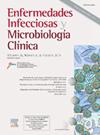Effectiveness of supplementation with different doses of calcifediol in HIV patients with vitamin D deficiency
IF 2.5
4区 医学
Q3 INFECTIOUS DISEASES
Enfermedades infecciosas y microbiologia clinica
Pub Date : 2025-06-01
DOI:10.1016/j.eimc.2024.11.009
引用次数: 0
Abstract
Background
People with HIV (PWH) often exhibit vitamin D deficiency, with ambiguous treatment guidelines. This study evaluates the effectiveness of three vitamin D3 calcifediol supplementation regimens over 48 weeks, aiming to identify patients whose serum levels do not increase above 20 ng/mL.
Methods
In this prospective observational study, 112 HIV-positive outpatients with 25OHD levels below 20 ng/mL were assigned to one of three supplementation groups. Group 1 received 16,000 IU weekly for 12 weeks, then biweekly; Group 2 received 180,000 IU every 12 weeks; Group 3 received 180,000 IU every 4 weeks for the first 12 weeks, then every 12 weeks. The groups were compared using ANOVA and Chi-squared tests.
Results
The average participant age was 51.59 years, with 71.4% being male, all on antiretroviral therapy for an average of 9.5 years. By week 48, Group 1 showed the lowest percentage of patients with levels below 20 ng/mL (10.2%), significantly outperforming Group 2 (44%) and Group 3 (31.6%). Vitamin D levels significantly increased in Groups 1 and 3, with no significant change in calcium, phosphorus and bone density between groups. The CD4:CD8 ratio increased significantly in all groups. No side effects were observed.
Conclusions
The regimen of 16,000 IU calcifediol weekly for 12 weeks followed by biweekly dosing is both safe and effective for PWH, significantly increasing vitamin D levels and improving the CD4:CD8 ratio without adverse effects.
补充不同剂量钙化二醇对维生素D缺乏症HIV患者的疗效
HIV感染者(PWH)经常表现为维生素D缺乏症,治疗指南不明确。本研究评估了三种维生素D3钙化二醇补充方案在48周内的有效性,旨在确定血清水平不高于20 ng/mL的患者。方法在这项前瞻性观察研究中,112例25OHD水平低于20 ng/mL的hiv阳性门诊患者被分配到三个补充组之一。组1每周服用16000 IU,连续12周,然后每两周服用一次;组2每12周给予180000 IU;第3组前12周每4周给予180,000 IU,后每12周给予一次。各组间比较采用方差分析和卡方检验。结果参与者平均年龄为51.59岁,男性占71.4%,接受抗逆转录病毒治疗的平均时间为9.5年。到第48周,第1组低于20 ng/mL的患者比例最低(10.2%),明显优于第2组(44%)和第3组(31.6%)。第1组和第3组维生素D水平显著升高,各组间钙、磷和骨密度无显著变化。各组CD4:CD8比值均显著升高。未观察到任何副作用。结论每周服用16000 IU钙化二醇,连续12周,然后每两周给药,治疗PWH安全有效,可显著提高维生素D水平,改善CD4:CD8比值,无不良反应。
本文章由计算机程序翻译,如有差异,请以英文原文为准。
求助全文
约1分钟内获得全文
求助全文
来源期刊
CiteScore
2.10
自引率
8.00%
发文量
194
审稿时长
29 days
期刊介绍:
Hoy está universalmente reconocida la renovada y creciente importancia de la patología infecciosa: aparición de nuevos agentes patógenos, de cepas resistentes, de procesos con expresión clínica hasta ahora desconocida, de cuadros de una gran complejidad. Paralelamente, la Microbiología y la Infectología Clínicas han experimentado un gran desarrollo como respuesta al reto planteado por la actual patología infecciosa. Enfermedades Infecciosas y Microbiología Clínica es la Publicación Oficial de la Sociedad Española SEIMC. Cumple con la garantía científica de esta Sociedad, la doble función de difundir trabajos de investigación, tanto clínicos como microbiológicos, referidos a la patología infecciosa, y contribuye a la formación continuada de los interesados en aquella patología mediante artículos orientados a ese fin y elaborados por autores de la mayor calificación invitados por la revista.

 求助内容:
求助内容: 应助结果提醒方式:
应助结果提醒方式:


